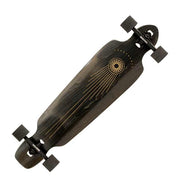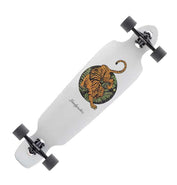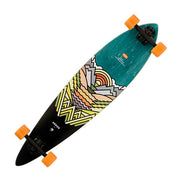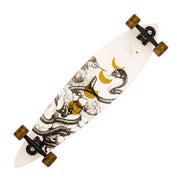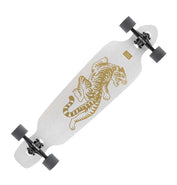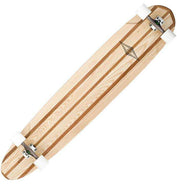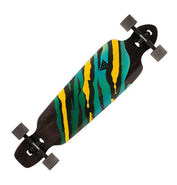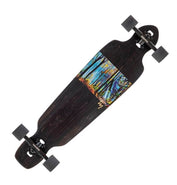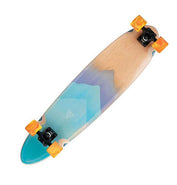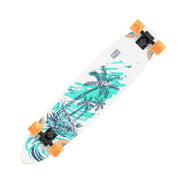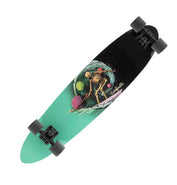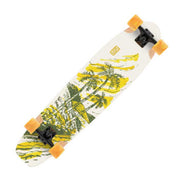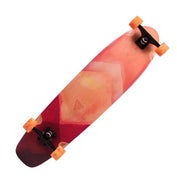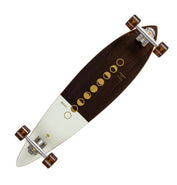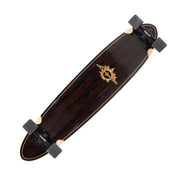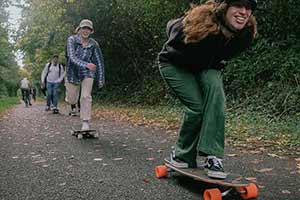Complete Longboards
Complete Longboards
If you are new to longboarding and don't want the hassle of building your own setup, this is the place to start. Check out our longboard beginner's guide for more info!
- What is a longboard anyway?
- What different kinds of longboards are there?
- Drop-through longboards
- Pintail longboards
- Dancing longboards
- Downhill and freeride longboards
- Short longboards
- Which longboard should I get?
- Should I get a cruiser board or a longboard?
- What are longboards best for?
- How much do longboards cost?
What is a longboard anyway?
A longboard is really just a big skateboard. The main differences are bigger and softer wheels, a longer and wider deck and turnier trucks.
There is a lot more variety in longboard shapes and sizes than you'll see on regular skateboards, and many other features to look out for like drop-through trucks and alternative constructions.
What different kinds of longboards are there?
Longboards come in all shapes and sizes. The most common are pintails, drop-throughs, drop-downs and dancing longboards. Beyond this there are many other more specialised varieties, like downhill and freeride longboards, pumping/long-distance boards, oversized skateboards and more. These are more optimised for certain types of longboarding.
The first thing to wrap your head around is the difference that the size of the board makes. Longer boards are more stable, shorter boards more agile, and so on. Check out our guide on choosing the right size longboard deck here.
Secondly, you have different styles of board. Including, but not limited to, the following:

Drop-through longboards
Drop-through longboards have the trucks mounted through the deck. This lowers the ride height and makes them perfect for beginners, for covering distance, and for learning to slide.
The lower ride height is inherently more stable - perfect for starting out comfortably - and also means that each push takes less effort. This makes a drop-through perfect for covering ground, be it a commute to work, a weekend cruise along the sea front or a full blown long distance trip.
It also means your weight is going sideways through the wheels when you carve, rather than on top and pushing down like a topmount. This makes for a surfy feeling, and an easier board to learn to drift and slide.
Pintail longboards
Pintail longboards are what many people picture as a classic longboard - roughly in the shape of a surfboard, think pointy nose and tail, wide under the front foot and tapering into the narrow tail.
They tend to be fairly long (or even really long, like the Hackbrett Wasser!) and the longer wheelbase adds stability to the ride. Pintails make a versatile first board - they will carve and cruise to your hearts content, have a big enough platform to try out some cross-steps, and will even go downhill and slide if you build up to it slowly.
Dancing longboards
Dancing longboards tend to be the longest boards, to give lots of platform for your footwork. With roots in longboard surfing, the shapes tend have now diverged and are often symmetrical and have a nose and a tail to pop the board up for tricks and into your hands.
There is some variability in length - true "dancers" are longer than "freestyle" boards, where the focus is more on those tricks. The boards are shorter and lighter, whilst still having enough room to let your feet flow between tricks.
Downhill and freeride longboards
Downhill and freeride longboards are in the same category and share a lot of similarities. They are finely tuned for going down hills fast with maximum control. They have no flex aside from perhaps a little dampening, often come with multiple wheelbase options and deck features that you won't see on your average cruiser.
Things like microdrops, W-concave, rocker and variable concave work together to create boards that really hug your feet and transform your ideas into reality as you fly down the hill. For many, this is the pinnacle of what can be achieved on a longboard.
Short longboards
An oxymoron, perhaps, but short longboards are for when you want that longboarding feeling - a bit of stability and leaning deep into your carves - but want the benefits of a cruiser board, too.
Shorter, lighter, more nimble, short longboards are a great go-between that will work in the city and down some bigger more rolling terrain, too.
A great example is the Lush Throttle, at 34" long it isn't a huge amount longer than some of the old school cruisers in stock. However, the longer wheelbase paired with a set of longboard (RKP) trucks makes for a much more stable ride that will handle some speed, yet still ollie, slide and trick to your hearts content.
Which longboard should I get?
Start off by thinking about how big you want your board to be, and what you want to use it for.
Bigger longboards have more room for your feet, and are generally a lot more forgiving to skate. Smaller boards and cruisers are quicker to turn and more manoeuvrable, but probably less suited to beginners. For a beginner's longboard, we recommend something between 36" and 46" long.
For more info check out our Choosing the right longboard size guide!
Should I get a cruiser board or a longboard?
Or rather - which one should I get first?
There are a few ways to look at this, but it boils comes down to what you want to do with it.
If you are skating shorter distances and value portability, we'd recommend you look at cruiser boards rather than longboards. They are smaller and harder to skate for total beginners, but the ability to ollie up and down kerbs and carry around a bit more easily makes them very suited to inner-city environments. For longer distances and a mellow, cruisier ride, a longboard is the way to go!
You could say:
City riding? Get a cruiser
Wide open spaces? Get a longboard
Or you can split it up by the speeds you're looking to go. Cruisers generally come with TKP (traditional kingpin, or regular skateboard) trucks, whereas most longboards feature RKP (reverse kingpin) trucks.
Don't ever want to go above jogging speed? A cruiser will suit you just fine
Need for speed? You'll want a longboard for sure
Want to do tricks? A cruiser will be more up your street
Just want to enjoy the flow? A longboard is all you need
As you can see, they both fulfil different roles and a well rounded quiver will surely have at least one of each. Perhaps a surfskate, too, but thats a different topic completely!
What are longboards best for?
Longboards are generally used for getting around, amd skating without pressure to learn tricks.
However, there are many kinds of longboard that are used for things other than just cruising about, including:
- Longboard dancing, boardwalking and tricks
- Downhill racing boards, maximum speed!
- Freeride and sliding, the art of going sideways!
- Shorter longboards (a bit longer than a cruiser board)
- Bigger skatepark boards, perfect if you like the idea of carving round a bowl without lots of technical coping tricks
How much do longboards cost?
We don't sell cheaper longboards here at Vandem - only the good stuff.
Complete longboards start at around £120, and go right up to £50 for a high-spec setup.
We would suggest that beginner longboarders start looking at boards from £130 to £200. That'll get you a solid complete with room to upgrade later.
Once you're into longboarding, a premium ride will set you back between £200 and £350. At this price point you're getting more specialised deck shapes and components, designed and manufactured by the finest minds in the business from the best longboard brands for the smoothest, fastest ride.
A world of composite decks, precision trucks and race wheels awaits beyond £350 - way more than most skaters will need.


